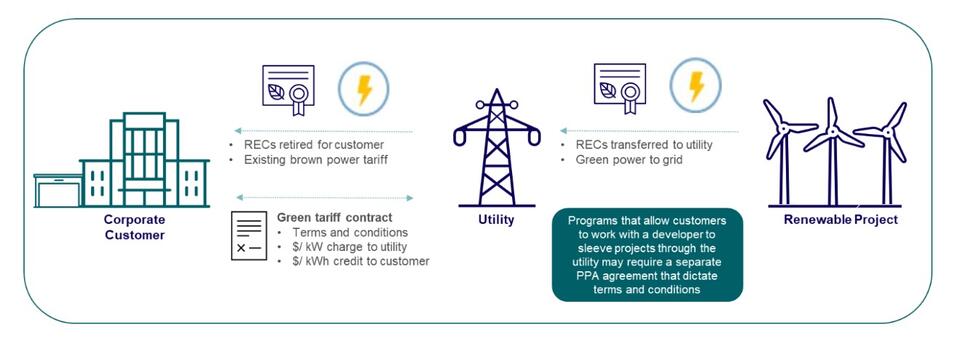Utility Renewable Programs 101: Understanding Green Tariffs, Green Pricing, and Utility Community Solar

By Matt Donath, Policy Manager
For commercial and industrial (C&I) businesses with clean energy and sustainability goals, navigating the world of renewable energy options can feel overwhelming, especially in states with regulated energy markets with limited options.
In recent years, utilities in these regulated states have expanded their renewable energy offerings to include programs like green tariffs, green pricing, and utility-sponsored community solar, which can become an important part of your clean energy portfolio. In this blog article, we will cover the basics of these program types, highlighting their benefits and which businesses they’re best suited for.
The lowdown on utility programs
The different types of utility programs share some similarities. One common element is that enrolling in a utility program typically does not alter your underlying power tariff, meaning that you are still billed for your brown power as usual.
Another similarity is that utility programs in regulated states must be approved by the state’s utility commission or board. This often means that the program structures are relatively rigid, with defined terms and a structure that allows little room for customer input.
Most programs retire renewable energy credits (RECs) on the customer’s behalf, allowing those who enroll to reduce scope 2 emissions and make claims regarding renewable energy. Retiring a REC means that it can no longer be sold or traded, and you retain ownership of it. It must also be registered through the REC’s tracking system, and only the party who retires it can claim environmental benefits.
Green tariff programs
Green tariff programs offered by utilities allow businesses to purchase RECs through long-term contracts, typically tied to a specific renewable energy project. These contracts resemble the structure of a PPA or VPPA and usually include a fixed program charge and a variable crediting mechanism.
How they work:
Utilities allow large customers with high energy use to subscribe to a large renewable project built by the utility, or some allow customers to work with a developer directly to negotiate a PPA and pass it through the utility.
Businesses typically commit to long-term agreements (e.g., 10-20 years), helping utilities finance renewable projects.
Enrolled businesses pay a program charge per kW enrolled and receive a credit based on the kWh production of the system, often based on avoided fuel cost, capacity value, or other metrics. Program charges and credits are typically added to the customer’s monthly utility invoice.

Why they’re beneficial:
- Scalability: Green tariffs are tailored for large energy users, allowing businesses to match their substantial energy needs with clean energy sources, often allowing customers to match up to 100% of their electricity consumption.
- Ability to diversify renewable procurement: Green tariffs provide a way for customers to diversify renewable procurement for large businesses with multiple locations in the U.S. behind different utilities.
- Brand impact: Being tied to a specific, often local, renewable project enhances transparency and highlights a business’s commitment to sustainability.
Green tariffs are ideal for C&I customers with significant load behind a given utility that can commit to a long-term contract. Suitable customers could include manufacturers, data centers, or retail chains with multiple locations. They fit well as part of a larger renewable strategy and could be used to show short-term progress until larger renewable energy procurements can take place. A list of recently available green tariffs from the Clean Energy Buyers Association can be found here.
Green pricing programs
Green pricing programs allow businesses to voluntarily pay a premium on their utility bill to receive unbundled RECs typically not tied to a specific project. These programs are often more flexible than green tariffs and allow an easy entry point into procuring renewables.
How they work:
- Businesses pay an additional charge per kilowatt-hour (kWh) of electricity on their utility invoice in exchange for RECs being retired on their behalf.
- Programs allow customers to choose a percentage of electricity consumption to enroll in the program or select a number of blocks per month, depending on program structure.
- The utility typically contracts for national RECs from unspecified projects. The cost per REC may be at a premium compared to the national REC market and will always be cost-additive.
Why they’re beneficial:
- Flexibility: No long-term contracts are required, with most programs offering month-to-month or annual terms.
- Ease of access: Simple enrollment processes make it easy for businesses to get started. Programs may offer an online enrollment portal or a short-term contract to enroll, and customers may be able to start receiving RECs as early as the next billing cycle.
Green pricing programs are ideal for smaller businesses, those unable to commit to green tariffs, or those looking for a short-term solution. Green pricing programs often work best as a bridge solution to show short-term progress or fill gaps towards renewable energy or emission reduction goals.
Utility community solar programs
Utility community solar programs offer businesses a way to subscribe to a share of a local solar project and potentially financially benefit through bill credits based on production of the system. Community solar programs are somewhat unique compared to the other options offered by utilities, as the potential for bill savings may be more of a driver than retaining RECs.
Some community solar programs retire RECs on the customer’s behalf automatically, while others may have an additional charge to do so or not allow it at all. In these cases, businesses could explore procuring national RECs using utility bill savings or other methods to reduce emissions.
Of the three program options, utility-sponsored community solar is the least commonly offered, especially for large energy users. Programs may be designed specifically for residential or small commercial entities and may have a small carve-out for large energy users, if at all. It is important to review programs offered by your utility to fully understand the options.
How they work:
- Businesses subscribe to or purchase a portion of the output from a utility-scale solar project.
- The solar project generates electricity, and subscribers receive credits on their utility bills for their share of the output.
- Programs are often designed to provide enrolled customers with savings on their utility bills after a certain number of years enrolled.
Why they’re beneficial:
- Accessibility: There is no need for onsite solar installations, making it a great option for businesses with space constraints or lease agreements that make onsite projects unfeasible.
- Cost savings: Subscribers often benefit from bill credits, leading to potential cost savings compared to traditional electricity rates.
- Local impact: Investing in a community solar program supports local renewable energy development.
Utility community solar programs are ideal for C&I customers looking for potential bill savings or to invest in local projects. Programs may offer the opportunity to be an anchor subscriber to the project, which can come with additional cost benefits and marketing, tying companies to the community.
Leveraging utility programs like green tariffs, green pricing, and community solar can help your company reduce its carbon footprint, achieve sustainability targets, and become a leader in corporate responsibility. Each program type offers unique benefits, but all provide meaningful ways to meet sustainability goals while supporting the transition to clean energy. By understanding your energy needs and sustainability objectives, you can choose the program that best aligns with your business strategy.
Trio offers comprehensive services for C&I customers looking to develop a renewable energy roadmap, including evaluation of utility programs available across your business locations. If your company is interested in exploring utility programs, or discussing other renewables procurement options, please get in touch with one of our experts.
